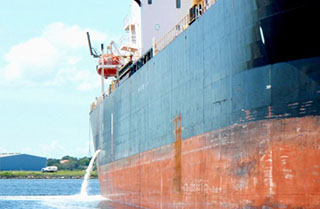A U.S. court case out of the Great Lakes, and Indonesia’s move to join an international convention on ballast water, means American operators need to plan now for a new set of water quality safeguards.
“If you don’t do anything else, get your record-keeping in order, come up with your plan. That’s what port state control is mostly about,” said Kevin Reynolds, a marine principal with Glosten Associates, Seattle, at a session on ballast water management at the International WorkBoat Show Wednesday.
Ballast water for years was an unpoliced frontier of environmental protection, blamed for introducing invasive organisms like zebra mussels and green crabs that foul U.S. waterways and compete with native fish species.
The U.S. 2nd District Court of Appeals ruled Oct. 5 in favor of the Natural Resources Defense Council and other environmental and wildlife groups, who contended the U.S. Environmental Protection Agency erred in not imposing stricter rules on ballast water, including treatment to eliminate organisms hitching a ride into North American waters.
That could bring a new revision of EPA and Coast Guard measures on ballast water, which now run through 2017.
Maritime nations began to address the problem almost 12 years ago, but building consensus for an International Maritime Organization convention on ballast water has been slow – until Indonesia’s move Nov. 24.
That appears to reach a trigger point for the IMO convention, when nations operating 35 percent of the world’s shipping tonnage sign on, Reynolds said. That could set Nov. 24, 2016 as the start date for implementation of new ballast water treatment systems, although the IMO could extend the time frames – as have U.S. authorities.
Ballast water regulation is a “low enforcement priority” for the Coast Guard, but starting in 2018 the service will want vessel operators to begin installing treatment systems at their next scheduled drydocking.
For U.S. workboats, older vessels can use in-tank treatment, like bleach and neutralizing solution, to clean ballast spaces. There are experiments ongoing with caustic soda too, Reynolds said.
One approved alternative is using fresh water from a regulated public supply for ballast, while using fresh water generated by on-board watermakers is under review, Reynolds said.
Glosten designs deck ballast modules for application on vessels like articulated tug barges. In those setups, ATB bilge water is pumped up to the module for treatment, and power equipment isolated in safe spaces to avoid contact with vapors.
In the long range, the answer to managing ballast water should not be arduous washing and rinsing of tanks, but “someone pushing a button” to activate automated treatment systems, Reynolds said. In the meantime, operators can look to those alternative treatments like ballasting with fresh water or fuel.





